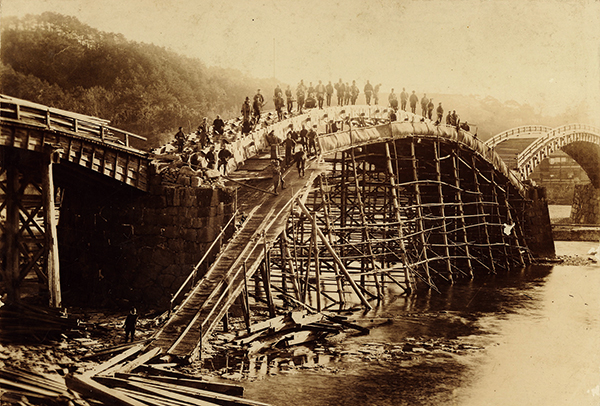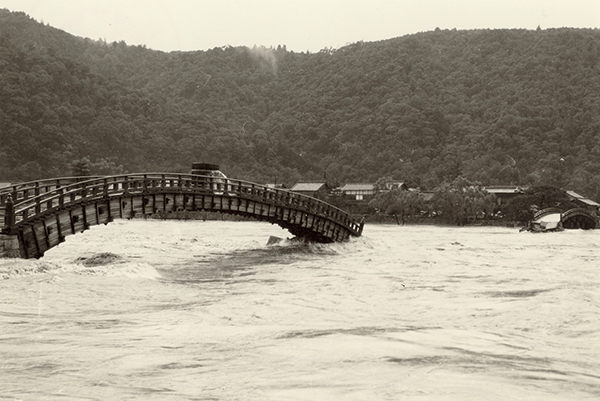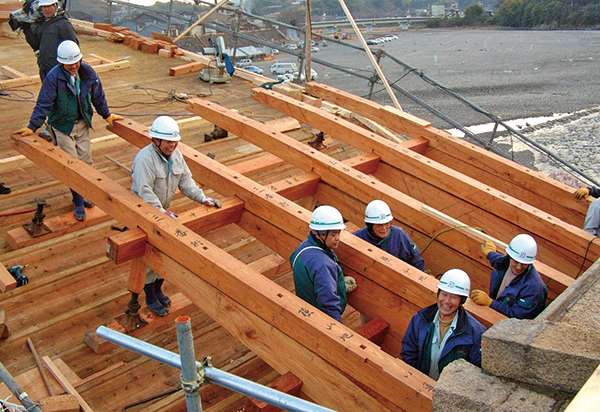Overview
Place of Scenic Beauty, Kintaikyo Bridge
The Kintaikyo Bridge is a five-span bridge over the Nishiki River in Iwakuni City, Yamaguchi Prefecture.
Counted as one of Japan’s three most famous bridges, with abundant nature in its background, it has been designated as a national Place of Scenic Beauty (the area including upstream and downstream).
It was constructed in 1673 through a manifestation of wisdom and skill, in the desire for a flood-proof bridge. That structure, crossing the river’s width of around 200m, is exquisite and original. Furthermore, it boasts a beautiful shape.
In approximately 350 years since its construction, the technology and beauty of the Kintaikyo Bridge continue to be protected even today.


History
From the Warring States Period to Peacetime
The Kikkawa Clan, who belonged to the Western Army the loser in the Battle of Sekigahara, was banished from Izumo Province area to Iwakuni, reducing their land value from 140,000 koku units to 30,000 koku. Times were still so tense that a war could break out at any moment. Hiroie Kikkawa, first lord, established his center of political affairs in Yokoyama. This was because the area’s topology, intersected by the Nishiki River with mountains in the background, was advantageous in terms of defense.
A bridge was constructed early on, in order to connect the castle town segmented by the Nishiki River. However, the bridge was washed away every time the river flooded.
Eventually, when the shogunate system came into place and a peaceful age arrived, the construction of a flood-proof bridge became the earnest wish of Iwakuni Domain.

“Map of the Inner Domain” (1668)
The area intersected by the Nishiki River, with Mount Shiroyama in the background was chosen as the residence of the feudal lord and some of his vassals, and the opposite riverbank was chosen for the dwellings of the remaining majority of vassals and the townspeople.
From the collection of Iwakuni Chokokan Museum
Concept and Foundation of the Bridge
Hiroyoshi Kikkawa, third lord, grappled with research on bridges, but a solution was not easily reached.
One day, Hiroyoshi obtained a book on China’s famed West Lake from the Ming Chinese monk and scholar Obaku Dokuryu. In this book was an illustration of a six-arched bridge connecting five small islands. It is said that this is how Hiroyoshi acquired the idea for the Kintaikyo Bridge.
This concept was to build four piers in the Nishiki River and to connect them using five bridges. In order to achieve this, further research was repeatedly conducted in addition to the civil engineering and architectural techniques that were cultivated during the Warring States era.
Then in 1673, the concept and technology resulted in reality, as the Kintaikyo Bridge was built.
 Illustration for “Travel Records of the West Lake”
Illustration for “Travel Records of the West Lake”
It is said that Hiroyoshi acquired the idea for the Kintaikyo Bridge from a picture of a bridge that spanned the islands of the West Lake (China).
From the collection of Iwakuni Chokokan Museum
 Third Lord of Iwakuni
Third Lord of Iwakuni
Hiroyoshi Kikkawa
(1621-1679)
Constructed the Kintaikyo Bridge.
A Bridge Across the Ages
The year after its construction, the Kintaikyo Bridge was washed away due to collapse of its piers during a flood. However, restoration was immediately commenced, and the reconstruction work was completed within the year.
After this, the bridge supported the passage of people over many years, while undergoing frequent restoration and renewal. It was swept away again in 1950 in a typhoon, but the townspeople worked in unison to achieve reconstruction.
In this way, the Kintaikyo Bridge has spanned the ages, and even now continues to exist in the same shape in the same location.
Twelve drawings, with the 1699 blueprints as the oldest, and full-sized “templates” from modern times onwards, are in existence. These serve as evidence that the design of the Kintaikyo Bridge has been passed down for more than three hundred years.
Materials were selected in accordance with the properties, economic efficiency and procurement potential of timber, such as by using pine and zelkova as the main structural materials and rot-resistant woods such as Japanese cypress as decorative materials.
Even before the development of photography and filming, bridge-building technology was handed down through repeated drafting of drawings each time the bridge was rebuilt.
Because of this, the Kintaikyo Bridge now exists in a shape unchanged from three hundred years ago.
Inspection of early modern archaic maps indicates that the setting of the Kintaikyo Bridge has not altered from history to the present day. Moreover, records of historical renewal also inform us that the bridge’s location has remained unchanged.

“Kintaikyo Bridge Renewal Plan” (1699), the oldest extant drawing.
From the collection of Iwakuni Chokokan Museum
Chronology of Kintaikyo Bridge
| 1600 Keicho 5 | Battle of Sekigahara Hiroie Kikkawa receives 30,000 koku of land in the Iwakuni vicinity |
|---|---|
| 1664 Kanbun 4 | Hiroyoshi Kikkawa sees “Travel Records of the West Lake”, acquires the idea for the Kintaikyo Bridge |
| 1673 Enpo 1 | The Kintaikyo Bridge is constructed |
| 1674 Enpo 2 | Washed away by flooding Reconstruction |
| 1677 Enpo 5 | Rubble stones is strewn in the riverbed around the Kintaikyo Bridge, and the stone pavements are reinforced |
| 1699 Genroku 12 | Oldest extant plan is drawn |
| 1871 Meiji 4 | Abolition of the feudal system and establishment of prefectures |
| 1922 Taisho 11 | Designated a national Place of Scenic Beauty |
| 1943 Showa 18 | Additionally designated a scenic area |
| 1950 Showa 25 | The Kintaikyo Bridge is swept away by Typhoon Kezia |
| 1951 Showa 26 | Showa Reconstruction commences (completed in 1953) |
| 2001 Heisei 13 | “Heisei no kakekae”(renewal) commences (completed in 2004) |
 The Kintaikyo Bridge in the Meiji-era.Photographed from the mountain downstream from the bridge. The townscape of Yokoyama is on the left. Dwellings were still positioned along the bank, but the Kintaikyo Bridge is in the same location as the present day.
The Kintaikyo Bridge in the Meiji-era.Photographed from the mountain downstream from the bridge. The townscape of Yokoyama is on the left. Dwellings were still positioned along the bank, but the Kintaikyo Bridge is in the same location as the present day.
 1898 Meiji 31
1898 Meiji 31
Renewal
 1950 Showa25
1950 Showa25
The Bridge is swept away by a typhoon
 2001 Heisei13
2001 Heisei13
Renewal beam assembly


